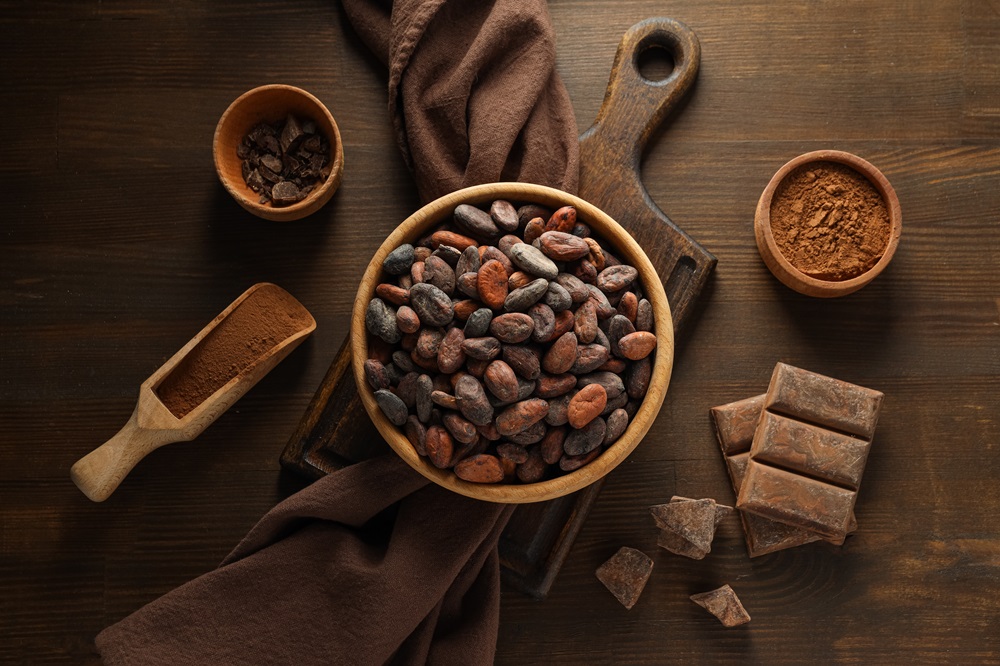Cocoa - Composition, Properties, Varieties

Cocoa is a product known and enjoyed by humans for hundreds of years. It comes from the seeds of the cacao tree and stands out for its richness in valuable nutrients and properties - cocoa may help support memory and concentration, as well as the proper functioning of the cardiovascular and nervous systems. It’s a versatile ingredient that can be used both in cooking and in cosmetics. What exactly is cocoa and what are its benefits? Does cocoa contain caffeine? Which type of cocoa is the healthiest?
Table of contents
What is cocoa?
Cocoa is a product with a rich history, used by humans for thousands of years. References to cocoa use can be found in ancient Aztec and Mayan texts, where cacao seeds were part of rituals and ceremonies. In the 15th century, a drink made from cocoa beans was served to warriors, and during World War II, cocoa was a basic component of soldiers’ rations.
Cocoa comes from the seeds of the cacao tree (Theobroma cacao) – a tropical plant native to South America, now also cultivated in Central America, Africa, and Asia. The cacao tree requires high humidity and warm air temperatures, can grow up to about 12 meters, and usually thrives in the shade of other trees. Its fruit is surrounded by a thick, red shell, and inside is a sweet, light-colored pulp with several dozen seeds. A single cacao tree produces about 50 fruits, each containing 20–60 cocoa seeds, most often used to make chocolate.
Cocoa - nutritional value
Cocoa has a low glycemic index and contains about 250 kcal per 100 g of powdered cocoa butter. The exact nutrient content of cocoa beans can vary depending on the product. In 100 g of cocoa powder, there can be about 20–27 g of protein and 10–21 g of fat. True cocoa is also a rich source of dietary fiber, providing about 30 g per 100 g of product.
When it comes to “cocoa - composition,” scientific studies indicate that unsweetened cocoa powder can contain as many as 300 different compounds.
These include:
- fatty acids, such as oleic acid and stearic acid,
- vitamins, including thiamine, niacin, folic acid, and vitamin K,
- minerals, especially magnesium, potassium, iron, and calcium,
- polyphenols, such as flavonols, anthocyanins, phenolic acids, and flavanols,
- amino acids, including tryptophan and serotonin,
- purine alkaloids, such as theobromine and caffeine – one tablespoon of cocoa beans contains about 23 mg of caffeine.
Cocoa - varieties
There are over 20 species of cacao trees, but only one is used to produce chocolate – Theobroma cacao L., which has several types. The most popular varieties are criollo, forastero, and trinitario.
Criollo, grown mainly in Venezuela and the Caribbean, has a delicate flavor and is a rare variety – due to its greater climate requirements, it makes up only about 3% of the world’s cocoa harvest.
The most common variety is forastero, known for its strong chocolatey, slightly bitter taste. It is mainly cultivated in Brazil, West Africa, and Southeast Asia, accounting for about 85% of the global cocoa supply, and is higher in fat than other varieties.
Trinitario is a hybrid that combines the strong aroma of forastero with the delicate taste of criollo. It is grown mainly in Madagascar, Central, and South America, and is more common than criollo but less than forastero.
Cocoa - properties
Cocoa is rich in valuable nutrients, which gives cocoa beans a range of potential health benefits. Scientific research suggests that regular cocoa consumption may improve blood lipid profiles by lowering total cholesterol and LDL levels. Cocoa may also have hypotensive effects, reducing both systolic and diastolic blood pressure. Thanks to the polyphenols in cocoa beans, they may improve blood vessel elasticity, reduce clot risk, and support heart and vascular health.
Flavanols in cocoa can help lower oxidative stress and dilate blood vessel walls, potentially increasing tissue sensitivity to insulin. Cocoa beans may also stimulate insulin secretion from pancreatic beta cells, reducing the risk of insulin resistance and type 2 diabetes.
Cocoa contains purine alkaloids – theobromine and caffeine – which can enhance concentration. Cocoa beans may stimulate the nervous system, improve cognitive function, sharpen focus and memory, and reduce fatigue. Cocoa flavonoids may also have neuroprotective and neuromodulatory effects, increasing blood flow to the brain and lowering the risk of neurodegenerative diseases.
Natural cocoa contains compounds that may improve mood and overall well-being. Studies suggest that cocoa components can promote endorphin production, reduce stress and tension, and boost positive mood. Additionally, cocoa may support immune system health through its anti-inflammatory effects, free radical neutralization, and oxidative stress reduction.
Some research suggests cocoa may aid in weight management. Cocoa compounds may speed up cellular lipolysis, stimulate thermogenesis, increase fat oxidation, and inhibit fat synthesis. Certain analyses also indicate that the taste and aroma of cocoa may help suppress appetite by lowering hunger hormone levels.
Which cocoa is the healthiest?
Due to its nutrient density and health-promoting potential, cocoa is considered a healthy product worth including in your diet. But with so many cocoa products on the market, which one should you choose?
Instant cocoa powders or granules, commonly found on store shelves, are often fortified with extra vitamins and minerals. However, they usually contain large amounts of added sugar, making them a poor choice. Flavored cocoa powders – vanilla or chocolate – are also not recommended, as they contain sugar, artificial flavors, and unnecessary additives.
The best choice is raw cocoa – natural, crushed cocoa beans that haven’t undergone chemical or high-heat processing. These fermented and dried seeds have high nutritional value and a rich profile of beneficial compounds. They contain no added sugar or fat but are naturally high in fiber.
When buying cocoa, check for certifications on the packaging – the Fairtrade certification is especially important, confirming the product was made through a sustainable production process.
How much cocoa can you eat per day?
Regular cocoa consumption can benefit the body. Current data suggests a daily serving of 2–3 tablespoons (about 20–30 g) of cocoa.
Cocoa - uses. How to use cocoa beans?
Cocoa has many uses. Most often, it’s found in the kitchen to make cocoa drinks with milk or water. Cocoa powder can also be added to oatmeal, desserts, baked goods, or smoothies. It can be combined with ingredients like avocado to create a healthy chocolate cream alternative.
Cocoa is used to make chocolate and chocolate-based products. In cosmetics, cocoa butter is an ingredient in masks, scrubs, and body lotions, as well as in sunscreens, shampoos, and hair conditioners. Cocoa beans are even used in perfumery to create unique fragrance notes.
Cocoa - contraindications and side effects
Cocoa is a natural product considered safe for human health and should not generally cause side effects. However, excessive cocoa consumption can lead to digestive issues such as diarrhea, constipation, nausea, or stomach pain.
Cocoa beans and cocoa-based products should be avoided by people allergic to cocoa – while rare, cocoa allergy can cause skin reactions, sneezing, abdominal pain, and in some cases, anaphylaxis. Cocoa is also not recommended for individuals with certain cardiovascular diseases or blood clotting disorders. It may also aggravate symptoms in people with stomach ulcers or gastroesophageal reflux, as cocoa can increase discomfort.

